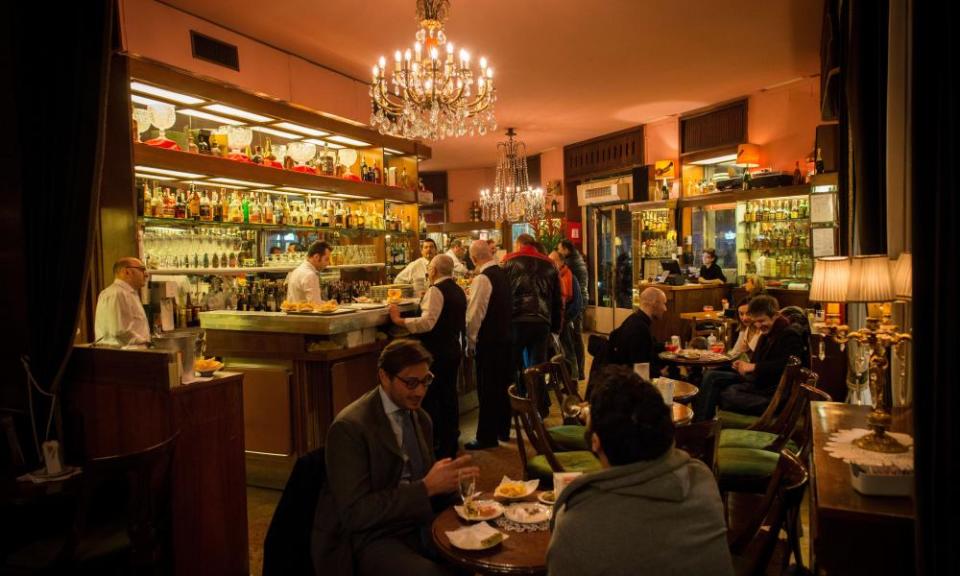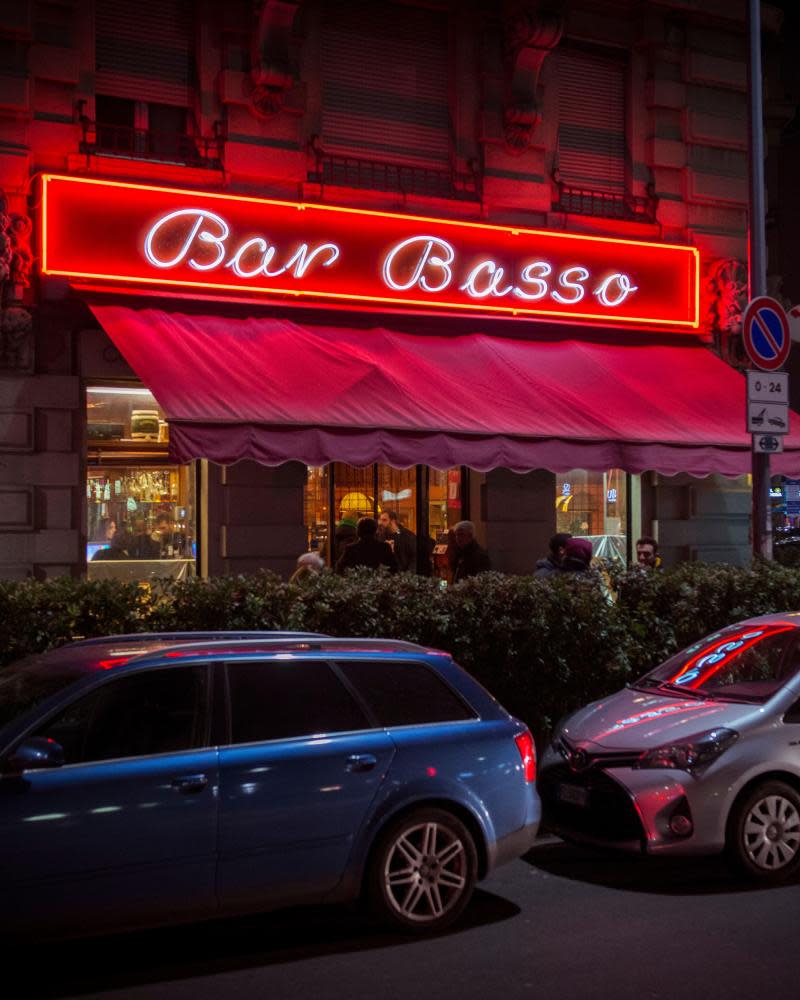Negroni sbagliato: the ‘wrong’ negroni was no accident – and it tastes fantastico
It’s 7pm on a Saturday evening in Milan, and a large crowd has gathered outside Bar Basso. Aperitivo hour has only just started, but inside the tables are already taken. From well-heeled locals puffing on HeatSticks to fashion types carrying tiny dogs, everyone is holding the same rust-coloured cocktail.
A negroni sbagliato translates as a “wrong negroni” or a “mistaken” one. Similar to a real negroni (gin, vermouth and Campari), it swaps the gin for sparkling wine. And like an Aperol spritz, when ordering it’s advisable to truncate it – spritz there, sbagliato here – if you want to pass as true Milanese. Behind the bar, five bartenders fill cocktail mixers with ice, then free-pour the liquor into goblets the size of pineapples. They make so many each night, they refer to them as “sba” as shorthand.
This year, the sbagliato turns 50. But while barely drunk outside Italy, it’s beginning to pop up in more discerning international establishments. The Rectory Hotel in the Cotswolds added it to its bar menu, with owner Alex Payne describing it as the “perfect drink on a hangover”.
The sbagliato entered British vernacular last autumn after House of the Dragon actor Emma D’Arcy declared in an interview that it was their favourite cocktail. The video blew up on TikTok, as these things do, “and now, here we are,” says Bar Basso’s owner, 62-year-old Maurizio Stocchetto.
The origin stories of the cocktail vary wildly but, despite the name, this cocktail was no accident. “It was conceived deliberately,” says Stocchetto. “In the early 1970s, after women’s liberation, women used to come to bars alone, so we needed something more suitable for a woman’s palate, and this had less alcohol,” he tells the Observer.
“I heard so many versions of this story over the years, so it is difficult to know which is true, but that’s the sbagliato – not a mistake.”

Packed crowds at the bar are now commonplace, says Stocchetto. “A few years ago, it was just during fashion week or design week in April. But these days we are always full.”
The bar is a well-known hangout among those in the rarefied art world. During miart, Milan’s contemporary art fair, REM frontman Michael Stipe would come in on his own, and just sit at the bar. “He did it three nights in a row, and no one bothered him,” Stocchetto says. On another rainy night, he shared a cigarette with front row regular Jefferson Hack, who founded youth and pop culture fanzine Dazed & Confused and Another Magazine. “I only know because I went home and googled him,” adds Stocchetto.
The neon sign outside Bar Basso has lit up the Porta Venezia district since Mirko Stocchetto, Maurizio’s father, heard the owner was “getting on” and bought the bar in the mid-1960s. It had first opened in 1947, and most of the furniture dates back to this postwar period. Sitting on the corner of a busy road in an area known for its nightlife, gay culture and design scene, Bar Basso is largely unchanged.
Shaped like a horseshoe, it has a long, curving bar and pre-pay counter. Large perspex buckets of plain crisps are decanted into bowls. “It’s very unpretentious, it hasn’t been gentrified,” says Stocchetto.
He started working here in 1976 when he was 16 and needed pocket money for petrol for his motorbike. “Then I got hooked by the bar life,” he says. Like his family, he still lives in an apartment above the bar.
When the family arrived in the 1960s, it was more of a gentleman’s bar. “You know, chauvinistic jokes – it wasn’t appealing to a woman,” he says. “Then women started to work in shops and offices and magazines, and we started seeing these women, independent – financially too – coming into the bar alone.”
Cocktails come and go, especially in the age of social media, where we’re as influenced as much by how something looks as how it tastes. Take the Aperol spritz, which took over the global bar scene in 2017 – thanks, in no small part, to a marketing campaign launched by Aperol’s owner, the Campari group. Piggybacking on the success of millennial rosé, and a precursor to New York’s hard-seltzer-in-a-can trend, the spritz was a marketing dream.

According to Gabrielle Bluestone’s 2021 book Hype, the cocktail’s rise was spearheaded by ad agency JWT New York, which aimed to “position the Aperol spritz as the … go-to drink for the social striver … that doesn’t mind splurging on the new/hot product if it advances their social status”. It helped, too, that the drink was aesthetically pleasing, the colour of a Riviera sunset, and served in comically round glasses.
Related: How the negroni sbagliato took off with the help of Emma D’Arcy and TikTok
The sbagliato also photographs well, and comes in Instagrammable glasses, designed by Stocchetto’s father so that the base was fat enough to prevent toppling over. But it faces stiff competition in the form of the Kir Royale (champagne and crème de cassis), which is also trending on Twitter thanks to its appearance in the second series of Emily in Paris, in which our (briefly) unemployed hero is advised to “sip, and do nothing”.
Stocchetto can relate to these success stories. “What you’re drinking is important, but more than that, it’s the community you drink with. In Milan during the 1970s, we saw riots and violence,” he says. “All the subcultures congregated at the bar, as well as the left wing and right wing. But nothing ever happened. It was peaceful, just drinking.”

 Yahoo Movies
Yahoo Movies 